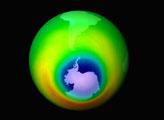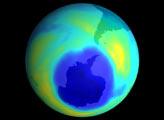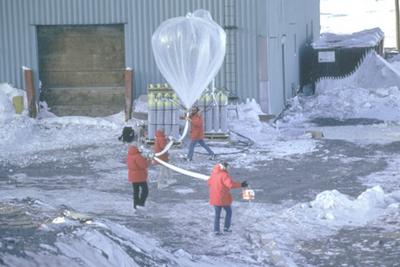9 December, 2004
What is an ozone hole and can you see it?
Good question! First, we should find out what ozone is...it is a chemical that is good for us so long as it is in the high atmosphere. It is not good to breathe ozone and when it is close to the Earth's surface, where we are, it is toxic. However, ozone high in the atmosphere above us is necessary to protect us from harmful light from the sun. This ozone prevents harmful light from reaching the Earth's surface...it acts like sunscreen for Mother Earth. We need this ozone in the high atmosphere to protect us. A hole in the upper atmosphere ozone layer can cause skin cancer, immune deficiencies, glaucoma (a disease of the eyes), sunburn, and it can affect our crops and animals.
You cannot see the ozone hole because both ozone and the ozone hole are clear, like out air. Imagine a column of air that starts at the ground and goes all the way to outer space. If you took all the ozone molecules in that column of air and squished them together, it would only be as thick as two stacked pennies (3 millimeters). When you think about it, that is pretty thin, and every molecule of ozone in our upper atmosphere is very precious to us!
Now, about the ozone hole. Our sun makes different kinds of light. Some kinds are good for us and some can harm us. The harmful kinds are called UV. If you read the label on sunglasses, they might say they filter all UV light. That is good! When you buy sunscreen, it has a number on it to tell you how strong a filter it is. The higher the number, the more UV it filters.
Certain chemicals that humans make get into the atmosphere and collect in the air above Antarctica. They go there because of the way the winds circulate air around the Earth. These chemicals are attracted to ice crystals. As you might guess, Antarctica's clouds are very, very cold, and they contain lots of ice crystals. So these two things are necessary ingredients in making the ozone hole - the chemicals and the ice crystals in the clouds. There is one more very important ingredient - sunshine.
As you know, during winter in Antarctica, the sun does not rise and set like it does where you live. Winter is dark all the time, and summer is light all the time, 24 hours a day! Remember the chemicals that have been collecting on the ice crystals in the high, cold, Antarctic clouds? Well, when the sun rises in Antarctica after the long winter, the sunlight reacts with these chemicals that have been stored up during the darkness of winter. When the sun hits the chemicals and ice crystals, chemical reactions take place and ozone is destroyed. The reaction can make some very unusual colors in the clouds. Below is a picture of some clouds...they are very beautiful, but what you must remember is that what you see in this picture is ozone being destroyed.
SO WHAT CAN WE DO ABOUT IT? One thing we can do is control the release of those dangerous chemicals into the atmosphere. Several countries have decided to stop making many of these chemicals. The chemicals are used for many different kinds of things including the computer industry, certain types of fire extinguishers, refrigerators, and in air conditioners in houses and cars. Many of these have chemicals have already been replaced with less dangerous kinds of chemicals, but many more are still in use and need to be replaced.
The following pictures are provided courtesy of NASA. They show the extent of ozone thinning. Dark blue colors show the area with the least amount of ozone. The darker the blue color, the less the amount of ozone. Green and yellow areas show progressively thicker ozone.

1: Nacreous clouds are where ozone is destroyed.

2: The ozone hole in 1999.

3: The ozone hole in 2000.

4: A balloon used to measure ozone entering the atmosphere

5: Measuring harmful UV light.
Contact the TEA in the field at
.
If you cannot connect through your browser, copy the
TEA's e-mail address in the "To:" line of
your favorite e-mail package.
|
